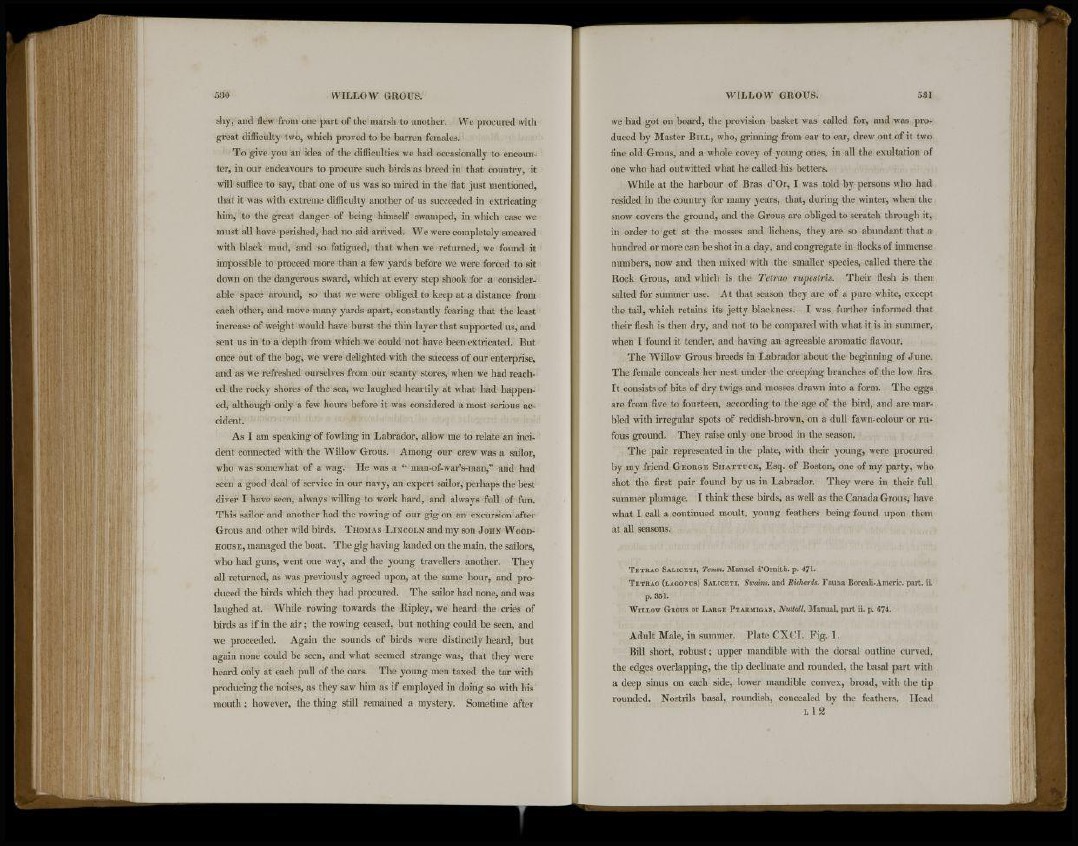
530 WILLOW GROUS.
shy, and flew from one part of the marsh to another. We procured with
great difficulty two, which proved to be barren females.
To give you an idea of the difficulties we had occasionally to encounter,
in our endeavours to procure such birds as breed in that country, it
will suffice to say, that one of us was so mired in the flat just mentioned,
that it was with extreme difficulty another of us succeeded in extricating
him, to the great danger of being himself swamped, in which case we
must all have perished, had no aid arrived. We were completely smeared
with black mud, and so fatigued, that when we returned, we found it
impossible to proceed more than a few yards before we were forced to sit
down on the dangerous sward, which at every step shook for a considerable
space around, so that we were obliged to keep at a distance from
each other, and move many yards apart, constantly fearing that the least
increase of weight would have burst the thin layer that supported us, and
sent us in to a depth from which we could not have been extricated. But
once out of the bog, we were delighted with the success of our enterprise,
and as we refreshed ourselves from our scanty stores, when we had reached
the rocky shores of the sea, we laughed heartily at what had happened,
although only a few hours before it was considered a most serious accident.
As I am speaking of fowling in Labrador, allow me to relate an incident
connected with the Willow Grous. Among our crew was a sailor,
who was somewhat of a wag. He was a " man-of-warVman,11 and had
seen a good deal of service in our navy, an expert sailor, perhaps the best
diver I have seen, always willing to work hard, and always full of fun.
This sailor and another had the rowing of our gig on an excursion after
Grous and other wild birds. THOMAS LINCOLN and my son JOHN WOODHOUSE,
managed the boat. The gig having landed on the main, the sailors,
who had guns, went one way, and the young travellers another. They
all returned, as was previously agreed upon, at the same hour, and produced
the birds which they had procured. The sailor had none, and was
laughed at. While rowing towards the Ripley, we heard the cries of
birds as if in the air; the rowing ceased, but nothing could be seen, and
we proceeded. Again the sounds of birds were distinctly heard, but
again none could be seen, and what seemed strange was, that they were
heard only at each pull of the oars. The young men taxed the tar with
producing the noises, as they saw him as if employed in doing so with his
mouth; however, the thing still remained a mystery. Sometime after
WILLOW GROUS. 531
we had got on board, the provision basket was called for, and was produced
by Master B I L L , who, grinning from ear to ear, drew out of it two
fine old Grous, and a whole covey of young ones, in all the exultation of
one who had outwitted what he called his betters.
While at the harbour of Bras d'Or, I was told by persons who had
resided in the country for many years, that, during the winter, when the
snow covers the ground, and the Grous are obliged to scratch through it,
in order to get at the mosses and lichens, they are so abundant that a
hundred or more can be shot in a day, and congregate in flocks of immense
numbers, now and then mixed with the smaller species, called there the
Rock Grous, and which is the Tetrao rupestris. Their flesh is then
salted for summer use. At that season they are of a pure white, except
the tail, which retains its jetty blackness. I was further informed that
their flesh is then dry, and not to be compared with what it is in summer,
when I found it tender, and having an agreeable aromatic flavour.
The Willow Grous breeds in Labrador about the beginning of June.
The female conceals her nest under the creeping branches of the low firs.
It consists of bits of dry twigs and mosses drawn into a form. The eggs
are from five to fourteen, according to the age of the bird, and are marbled
with irregular spots of reddish-brown, on a dull fawn-colour or rufous
ground. They raise only one brood in the season.
The pair represented in the plate, with their young, were procured
by my friend GEORGE SHATTUCK, Esq. of Boston, one of my party, who
shot the first pair found by us in Labrador. They were in their full
summer plumage. I think these birds, as well as the Canada Grous, have
what I call a continued moult, young feathers being found upon them
at all seasons.
TETRAO SALICETI, Temm. Manuel d'Ornith. p. 471-
TETRAO (EAGOPUS) SAEICETI, Swains, and Richards. Fauna Boreali-Americ. part. ii.
p. 351.
WIEEOW GROUS or LARGE PTARMIGAN, Nuttall, Manual, part ii. p. 674.
Adult Male, in summer. Plate CXCI. Fig. 1.
Bill short, robust; upper mandible with the dorsal outline curved,
the edges overlapping, the tip declinate and rounded, the basal part with
a deep sinus on each side, lower mandible convex, broad, with the tip
rounded. Nostrils basal, roundish, concealed by the feathers. Head
L 1 2